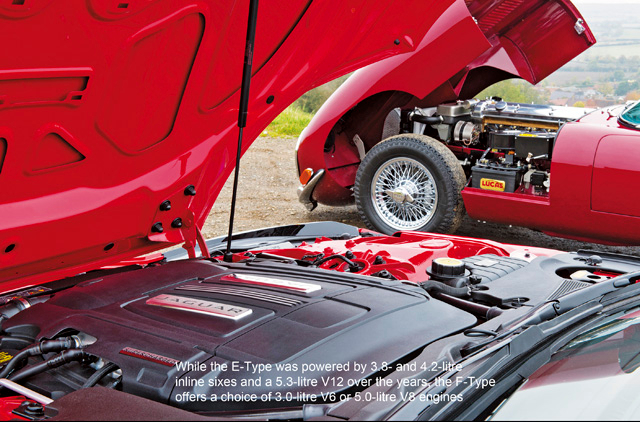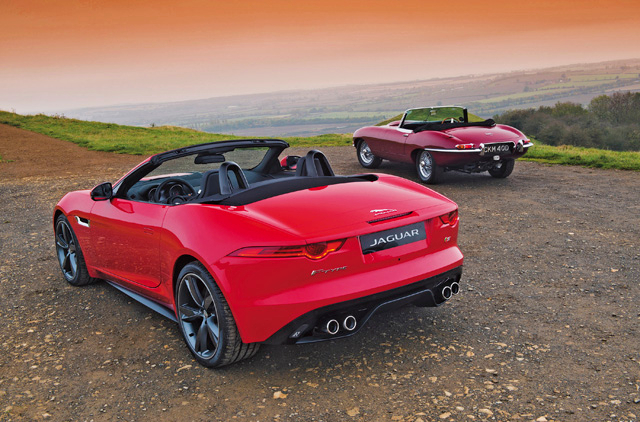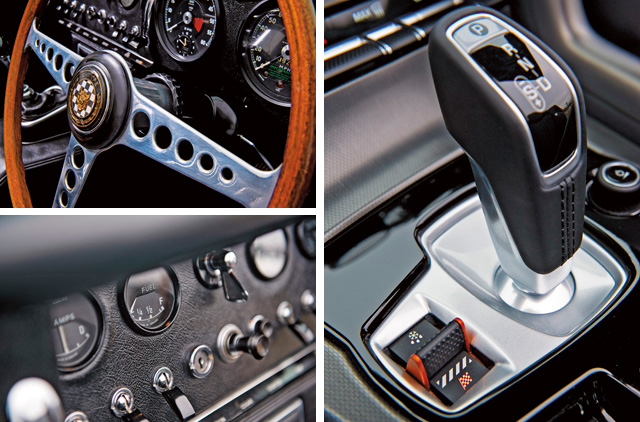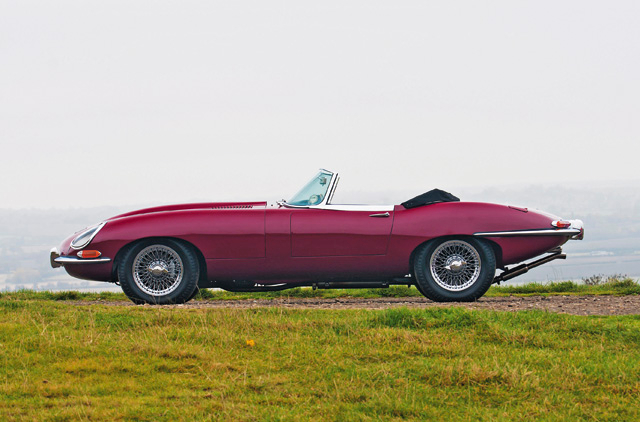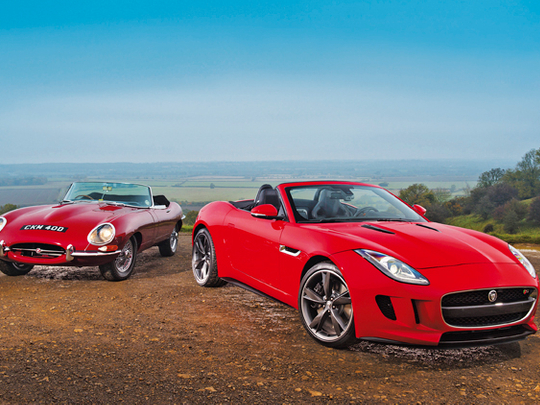
The plates are delivered and a potentially heart-stopping Scottish breakfast is placed in front of me as I sit chatting to Jaguar’s director of design, Ian Callum. Like me, he’s home in Scotland, and comfortable. We would describe the weather outside as driech – overcast, cold and generally pretty miserable. But with warm food on our plates — Callum and I claiming ownership of the origin of some of the more interesting fried morsels to Jaguar’s Irish PR lady, who reckons they’re Irish — mixing with talk of design, Callum is engaging, entertaining company.
This morning Callum wants to talk boats, specifically the concept powerboat he’s created as a side project as “a bit of fun.” That bit of fun is absolutely beautiful — Callum’s creation a bright spot in the otherwise grey view outside. I’m not here to talk about the boat though, instead steering the conversation to arguably the most important Jaguar Callum has penned to date, the F-Type. Callum admits that more than any of his other creations, he’d buy an F-Type. It’s car he describes as ‘happy’, and one he’d give garage space to.
He would have a job finding space, as his garage is already pretty full of some interesting metal. The conversation meanders from fried breakfasts, through boats, to his Mini, a Jaguar MkII project he’s working on and his glorious steel-bodied Ford Deuce coupé hot rod. There’s a Chevy in his garage too — Callum, not long done designing Jaguar’s XF Sportbrake estate car, musing that he wished it was a Nomad. A proper car guy, then.
The F-Type might have been discussed almost since the demise of the E-Type, but Callum admits it wasn’t in Jaguar’s immediate plans. Indeed, while Callum and his design team — made up of Matt Beaven, Julian Thomson and Alister Whelan — have long played with ideas for an F-Type, it wasn’t in Jaguar’s product plan. The F-Type’s arrival can largely be attributed to Ratan Tata, the industrialist and owner of Jaguar Land Rover, was determined that Jaguar should produce a new sportscar.
The F-Type was fast-tracked as a result, being added to the company’s cycle plan and going from concept to production reality in just two-and-a-half years. The process would usually take longer, not least as there’s normally a demand for several proposals before choosing a final design. That wasn’t the case with the F-Type, the car parked alongside its ancestor here is largely as it was initially conceived.
The changes from start to finish were slight, Tata himself having input, the trained architect influencing the design of the headlamps, stating that they should follow the lines of the bonnet and wings, rather than dissect them. Callum clearly enjoys the time with Tata, saying that he “really bought into the brand,” understanding at its core that Jaguar is about sportscars. The F-Type’s comparison with the E-Type is inevitable, and the new car’s arrival gives us an excuse to bring along its iconic relative, an absolutely beautiful Series I 4.2 roadster owned by Nigel Harper.
Despite the obvious comparisons, Callum was adamant from the outset that the F-Type wouldn’t be a retro-inspired pastiche of Jaguar’s most iconic model. He concedes, “of course the E-Type was in the back of our minds when we designed it, but I told my team to forget about it,” countering some internal pressure from Jaguar insiders to replicate the famously curvaceous shape of the Sixties machine. That E-Type is, as Callum says, “beautiful, but it’s of an era, when you see the cars together you can see that one is now and one is then.” That’s obvious seeing them side by side for our exclusive photo shoot.
The E-Type is, as Callum says, stunning, though it was created at a time that was completely unhindered by the regulation that dictates lighting, pedestrian safety and suchlike today. Release the E-Type’s bonnet, allow it to swing forward on its beautifully balanced hinges and nose under there and the reward is mechanicals as artistry. The reality is, it’s unlikely that much thought was given to how it looked under there, its beauty more a by-product of mechanical necessity than any nod to the aesthetic, but it is a glorious sight.
The F-Type by comparison is utterly bereft of anything to see under its bonnet, unless plastic cladding and airbag warning labels for the pop-up bonnet are your thing. The interiors mark the passage of time too — the E-Type’s toggle-switched, haphazard layout at odds with the F’s modern, ergonomically considered and airbag-equipped cabin. For the F, Callum admits to admiring the panoramic-style interior of the Porsche 928, penned by fellow Scotsman and Royal College of Art contemporary Dawson Sellar.
He wanted drama and driver focus, and the dashboard as low as possible, the solution being the pop-up vents on the centre console, which only come up when they really need to, and have the added element of ‘surprise and delight’. The deliberate technical, mechanical feel of the switches was driven by his team member Thomson, while the gearlever — in place of Jaguar’s now signature pop-up auto shifter — was pushed by many inside the firm, as well Tata, himself.
It’s not Callum’s favourite aspect of the interior, liking the simplicity and space-saving pop-up shifter instead, though he concedes that in a sportscar it works. Over 45 years separate the two cars, and while Callum’s respective nod to the E is more obvious when they’re sharing space, the differences between them delineate the passage of time dramatically. Describing the F-Type’s design as “for first principles,” Callum admits that “any similarities are the result of first principles rather than trying to emulate something else”.
There are some signature styling cues, which, when you see the two cars side by side, define lineage. Callum isn’t apologetic about this, singling out the taillights as very evocative and very Jaguar, saying, “if we’re going to pull something from the past and use it as a point of inspiration then there’s nothing wrong with that, as long as it stands with merit in its own right.” Reminiscent of Jaguars of the past, but very modern. The fabric roof? The idea of a folding hard top came and went quickly, having been explored and dismissed previously with the XK.
The folding soft top was seen as “a hugely efficient piece of technology,” the Z-fold helping enormously with packaging the car — crucial in a vehicle the designer describes as being “stretched over the mechanicals.” The only indulgence Callum admits is the line over the rear haunches, loving the purity of the form and the tapering to a defined conclusion at the rear. It’s a stunning car, one that I admit to Callum didn’t impact as I’d anticipated when seeing it for the first time on the stand at the Paris Motor show.
He understands that completely, saying there’s nothing like natural light and its proper low-down-on-road position — rather than harsh artificial light and high mounted plinths of a show stand — to best demonstrate the lines and stance of a car. Even in the company of the E-Type, it’s the car that’s getting all the attention. That’s the intention — the F-Type is crucial as a brand builder for Jaguar, but the roadster has exceeded even the most optimistic insider’s expectations.
Adrian Hallmark, global brand director of Jaguar, admits that initial interest from the web and dealer contact in the new sportscar rivals that of the huge- selling Range Rover Evoque. While a good number of those contacts might not be converted into sales, the F-Type’s job in pushing the Jaguar brand into the public’s consciousness cannot be underestimated. It’s unlikely it’ll ever manage to permeate and cement itself quite as readily as the E-Type did, but the F-Type exists in an entirely different world.
The expectation that the F would fulfil a Porsche Boxster-rivalling role in the Jaguar line-up hasn’t transpired either, initial pricing pushing it nearer the Boxster’s 911 relation. That positioning hasn’t done anything to dent its appeal — Jaguar and Tata’s decision to produce a new sportscar regardless of the worldwide economic woe is evidently the right one. That’s no more obvious than when seen here, the F-Type wowing, looking so right, appealing hugely even alongside its E-Type relative. Callum alludes that there’s more yet to come.
That space in his garage wouldn’t be for a roadster, the designer confirming the open secret that the forthcoming F-Type coupé would be the preferred choice in that busy garage — if such a car were to happen, of course. He might need to lose something to make space for it though, or he could always build a bigger garage — and perhaps a boathouse, too.



